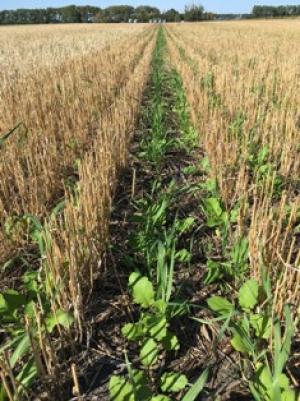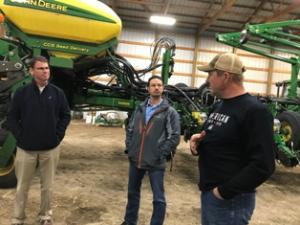Trust, Friendship Help Launch Soil Health Journey
A few years ago, Tyler Zimmerman switched to no-till on all of the 2,500 acres he farms in the southern Red River Valley. He did it all at once. One hundred percent of the farm
And he didn’t stop with no-till. Soon the Leonard, N.D., farmer was planting cover crops, adding cereals and specialty crops to his corn-soybean rotation, intercropping canola and peas, grazing livestock on crop aftermath and cover crops, and experimenting with planting corn in 60-inch wide rows and seeding cover crops between the rows.

Making such a sudden, complete change in farming practices goes against the advice to start small and go slow when trying something new.
But with only about 40 growing seasons in most farming careers and a determination to improve soil health as quickly as possible, “I didn’t want to waste any more time” Zimmerman says.
Zimmerman had been interested in no-till for 20 years. But there were very few people no-tilling in his area. He kept reading about the success farmers in other parts of the country were having with no-till and he gradually reduced amount of tillage he did to manage residue and prepare seedbeds. By the time he switched to no-till in 2015 he was making just one or two vertical tillage passes – one in the fall and one in the spring -- and had successfully planted directly into a cover crop that he had seeded on Prevented Planting acres.
NRCS visit
A visit to his local NRCS office in 2015, led to becoming confident enough to switch to no-till.
“I hadn’t worked with NRCS much before,” he says. “It’s a federal agency, and I was a little hesitant having the government even more involved in my farm than it already was.”
But Zimmerman got to know Joshua Monson, the district conservationist, and others in the NRCS Fargo field office.
He liked that Monson asked about the goals he had for the farm. He listened to what wanted to accomplish and why.
“He didn’t try to tell him how to farm,” Zimmerman says.
Instead, Monson helped him meet farmers and North Dakota State University specialists who he could talk to about no-till and other soil health practices.
“We became friends,” Zimmerman says of Monson.

When Monson told him about NRCS programs that were available to help reduce the financial risk of trying no-till and cover crops, Zimmerman was ready to listen.
“I trusted him,” Zimmerman says.
Zimmerman also credits his life-long friend and neighbor, Chris Walberg, also from Leonard, with helping him make no-till work. Walberg farms and ranches nearby and started no-tilling all of his land a year or two after Zimmerman.
Being able to talk about problems and solutions with other farmers – especially local farmers -- is so important that Zimmerman and Walberg now invite neighbors to field tours and shop talks.
“The more people in our community that we can get involved, the better, “ Zimmerman says, “We can all learn from each other.”
Benefits apparent
Many of the -till benefits that Zimmerman had heard about no-till showed up right away. It took less labor and fuel to run his farm since there wasn’t any tillage to do. He was able to sell tillage implements and the big tractors he had been using to do tillage.
Improvements in soil tilth, organic matter, water infiltration and water conservation soon became apparent. The crop residue left on the soil surface and the cover crops protected the soil from wind and water erosion after the main crops were harvested.

Zimmerman’s soybean yield didn’t change when he switched to no-till. His corn yield dipped at first because he had to wait longer for some fields to be fit to plant. He has since increased his corn yields by selecting earlier maturing hybrids better suited to later planting dates and by adding a layby fertilizer to help the seedlings grow faster.
To diversify his rotation, Zimmerman had to replace some of the acres of his most profitable crops -- corn and soybean -- with the traditionally less profitable cereals and specialty crops. But the added yield over the whole rotation more than makes up for the difference.
“Our whole farm’s net profit is about the same as when we were doing tillage,” he says.
But now the Zimmerman is better positioned to be able to reduce costs in the future. He expects as soil organic matter and the microorganism populations on his farm rise, he’ll have the opportunity to reduce the amount of commercial fertilizer he has to apply to reach his yield goals. A healthier, more biological active soil should naturally produce more nutrients for crops.
The farm also should be better able to withstand and recover more quickly from difficult weather conditions. Long-term no-till soils with diverse crop rotations can have water infiltration rates that are as much as six times higher than tilled soils, Monson says. In wet years, less precipitation will run off and pond in low areas in no-till field fields than tilled fields. After a drought, the higher water infiltration rates will help recharge soil moisture level.
“No matter what kind of weather we have, the farm should be much better off,” Zimmerman says.
Media contact
Lon Tonneson
for the Natural Resources Conservation Service - North Dakota
lon.tonneson@gmail.com
701-361-1105

